How Angus Young overcame grief for AC/DC’s 17th album Power Up
AC/DC has built a career making minor variations on major themes, and so it is with the band’s first release since the death of founding guitarist Malcolm Young in 2017.
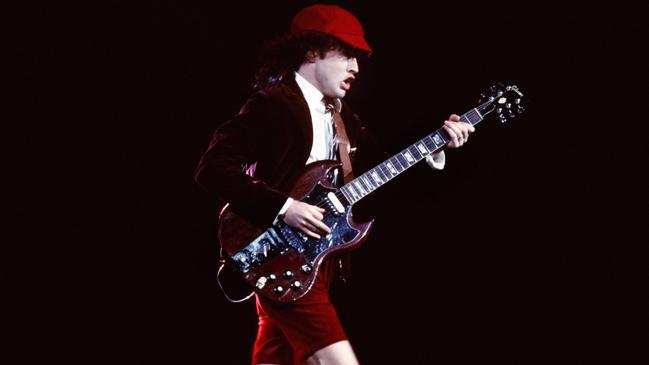
After the funeral service for his older brother and bandmate, Angus Young walked behind a pipe band and ahead of the coffin procession, carrying something in his right hand that meant the world to both men. Wearing faded blue jeans and a black blazer, the lead guitarist and songwriter of AC/DC left St Mary’s Cathedral in an entirely different outfit to almost every other public appearance he makes.
For about four decades, Angus’s onstage persona has been a headbanging livewire in an adolescent hat, tie and blazer whose fretboard fireworks has inspired generations of boys and girls to plug in their guitars, turn up their amplifiers and try to do as the iconic rock ‘n’ roll Schoolboy does.
On the morning of Tuesday, November 28 2017, he was not performing but mourning, and the musical accompaniment was provided by a band of a different sort, led by drums and bagpipes in tribute to the family’s Scottish roots.
As the coffin entered the waiting hearse, Angus followed by sliding the most significant object in Malcolm’s life alongside it: secured inside a black road case was a golden Gretsch electric guitar that was far more than just another instrument.
It held totemic significance in the story of the world-conquering band, which the brothers formed in Sydney in 1973. Eventually they would scale the summit of rock ‘n’ roll together, thanks to what Malcolm could do with his hands, his brain and an instrument nicknamed The Beast, and what Angus could do with the same implements and a different make of guitar known as a Gibson SG, whose body was curved to two points that mimicked devils’ horns pointing at his busy left hand.
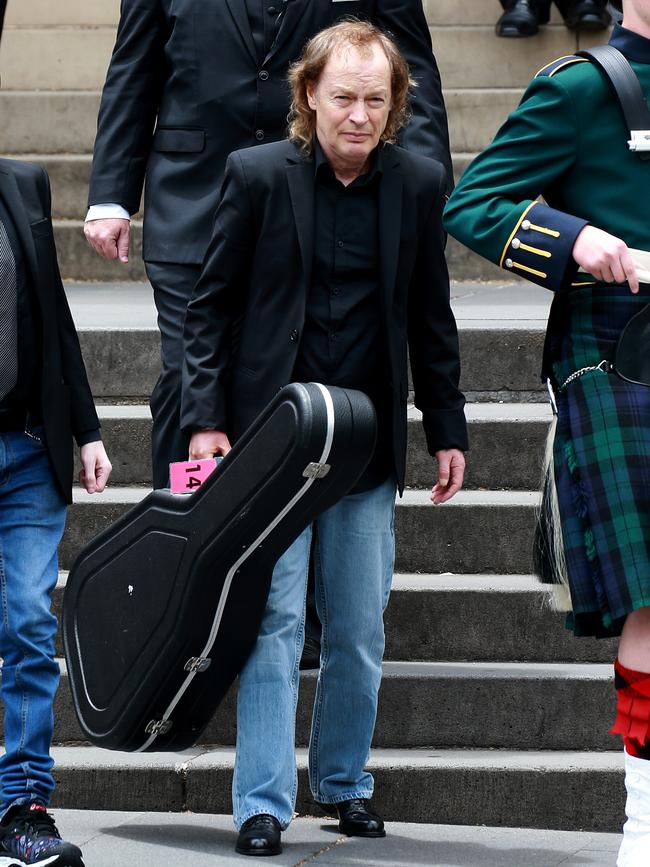
Speaking of that decision to send the Gretsch on his brother’s final journey, Angus says, “We just wanted something close with him, to him. That was his favourite guitar; he just loved it. He protected that guitar a lot, anywhere. After every tour, he made sure he had that guitar to go home with him, because that was the guitar that had been on all the AC/DC records. All that we had done, it had been done with that guitar.”
The magnitude of loss was doubly sad given that three weeks earlier, Angus had lost another older brother, George, who was a lead character in the story of the greatest band to ever form on these shores and take their music to the world.
As co-founder, guitarist and songwriter in The Easybeats, George authored an essential early entry in the songbook of Australian rock ‘n’ roll; later, as a songwriter and record producer, he would oversee scores of studio sessions, including the first five AC/DC albums, from High Voltage (1975) to Powerage (1978). George died in Singapore on October 22 2017, aged 70. He lived six years longer than Malcolm.
How does a man cope with losing two older brothers in such quick succession? “I don’t think I’ll ever recover, in that sense,” says Angus with a sad laugh. “They always say time’s a healer for things, but I mean, I do really miss them. Malcolm, the two of us spent so much time together, especially [with] work and because we were always busy, it’s a hell of a lot of time. And also, the same with George, especially when we were young. George was the one that always gave us so much help along the way.”
Together, Malcolm and Angus composed some of the most memorable songs in the history of rock ‘n’ roll; chord progressions and guitar riffs that sound simplistic to the ear but remain devilishly tricky to play. As long as human beings play guitars, there will always be someone, somewhere on the planet attempting to perfect an AC/DC song.
But dementia does not discriminate. It is a disease of forgetting: like a cancer, its effects start small but eventually overwhelm the brain, taking with it the ringing notes and unrelenting right-hand rhythm attack that Malcolm tracked on Back in Black, Highway to Hell, Thunderstruck, T.N.T. and dozens more songs that soundtracked his life in music.
It was on the Black Ice world tour — comprising 168 shows across nearly two years — that Angus began to notice his brother starting to have trouble remembering songs that he had played hundreds of times before millions of people. After consulting a specialist in the US and being prescribed medicine, he made it to the final show in Bilbao, Spain, but June 28, 2010 would be the last show that Malcolm ever played with AC/DC.
“He did really well with all of that touring, and it was only later on, after that, it really started to develop further,” says Angus of Malcolm’s condition. “And then you start seeing the deterioration. It’s awful to look at, and worse for him, because he would be trying to explain it to me. Because of a lack of [understanding of] what goes on with our brains, it’s very difficult. Those sort of diseases that affect the mind, they get new [medical] advances, but they’ve not come up with anything really great for it, I think.”
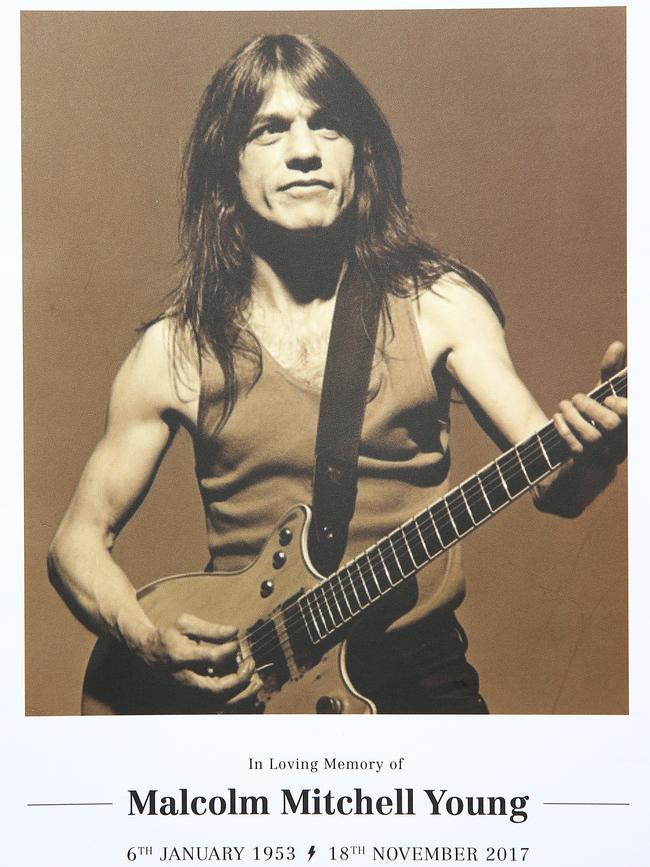
The Sydney funeral service in 2017 marked the public end of a substantial chapter of Angus’s life. His brother’s body and his prized possession were laid to rest, and what would come next for the sole remaining founding member of AC/DC was yet unwritten.
“But Malcolm and George, they themselves were always ones for [saying], ‘You’ve got to keep going’,” he says. “They both understood. I mean, even when [singer] Bon Scott died [in 1980], Malcolm was the same to me. After a week or so, he called me up and he said, ‘What are you doing?’ And I said, ‘I’m just moping’.”
“He was the same,” says Angus. “And he said, ‘Well, we’ll just go — the two of us — and we’ll get a little room together and we’ll just keep doing what we were doing before: just keep writing away. Don’t think of anything; just go in and just write away, and play away with songs’. And it helped. It really helped.”
And so, in time, he would follows his brothers’ urgings. He would keep going, and what he came up with would be built upon the mighty body of work that the Youngs had spent their collective lifetime creating.
As for Malcolm’s prized possession, which accompanied him across the world and alongside his coffin? It’s now with his family. Asked whether such an important instrument should be strummed in its owner’s absence, Angus pauses.
“Ah, he’d let me play it,” he says of The Beast. “He always let me play it; I don’t know about other folks, but he’d let me play it. I was the same way: he would play my guitar.”
■ ■ ■
AC/DC’s Rock or Bust world tour of 2015-2016 had been one of the strangest runs of the band’s long career, as near the end, longtime singer Brian Johnson — who joined the band in 1980, soon after Bon Scott’s death — was forced to make an urgent and apologetic announcement that he had to stop performing immediately lest he go permanently deaf.
“I am not a quitter and I like to finish what I start, nevertheless, the doctors made it clear to me and my bandmates that I had no choice but to stop performing on stage for the remaining shows and possibly beyond,” said Johnson in a statement. “That was the darkest day of my professional life […] For the moment, my entire focus is to continue medical treatment to improve my hearing. I am hoping that in time my hearing will improve and allow me to return to live concert performances.”
Into his place stepped Axl Rose, the singular singer of Los Angeles rock band Guns N’ Roses whose reputation for arriving several hours late to his own shows preceded him. Yet as the newest member in the tightly managed world of AC/DC, Rose was punctual and performed admirably in about two dozen concerts while labouring under a considerable weight of expectation.
After 88 shows across 17 months, the final concert of the Rock or Bust tour took place in Philadelphia in September 2016. The band’s future was uncertain, with most of its core members opting to leave by choice or circumstance. Stevie Young was filling his uncle Malcolm’s role on rhythm guitar; bassist Cliff Williams had announced he would retire after the tour; longtime drummer Phil Rudd was under house arrest in New Zealand on charges of drug possession and threatening to kill — Chris Slade had sat behind the kit in his place — and Johnson looked to be out of the picture forevermore owing to seemingly irreparable hearing damage.
As the last man standing from the original line-up, Angus recalls what came next after the Philadelphia show four years ago. “It’s a hard thing: in one way, I felt a little bit of relief, because I didn’t think we’d get through that tour, somehow,” he says with a laugh. “So in one respect, I felt really good. I felt a lot of pressure off my back — and sad in other respects, because Cliff had been there in the band [since 1977] … you know, it’s not my ideal choice how things happened at the time. But Malcolm used to say to me sometimes, ‘Well, it’s left to you and me to pick up the debris, now’.”
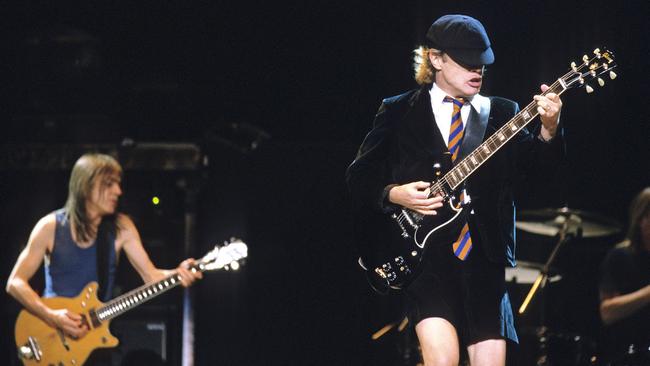
First, though, he needed a short break at home in Sydney to recharge his batteries. “I get antsy pretty quick; I don’t like to sit around too long,” says Angus. “I thought, ‘I’ll start going through a lot of song ideas.’ I did probably what I’ve always done: just put my head down and say, ‘OK, here we are. Get in your little room, your little studio, and start making a bit more music.’ And that’s what I did.”
Just as he did ahead of the release of 2014’s Rock or Bust, Angus set about sifting through a proverbial mountain of material that he and Malcolm had assembled over the years, much of it stored on CD and previously sorted into contenders for potential AC/DC songs.
Asked whether he and his brother had used some kind of rating system delineating golden ideas from silver or bronze, for instance, Angus laughs and replies, “No — stockbrokers do that. When the two of us used to be together, we would just get our ideas, and then say, ‘OK, we’ve worked on a few weeks of those’ — and then we pick a few days, and we go through them and listen for what we thought were strong AC/DC ideas. We did it that way, and the funny thing is, the great ideas — what you thought were good — they jumped out at you.”
While the guitarist, songwriter and lyricist chipped away at that mountain of riffs and sketches, Brian Johnson was undergoing an experimental treatment for his hearing issues that saw a scientist and inventor named Stephen Ambrose regularly visiting his home in Florida while finetuning and miniaturising a remarkable in-ear technology that would eventually restore Johnson’s hearing.
“It took two and a half years,” the singer told Rolling Stone earlier this month. “He came down once a month. We’d sit there and it was boring as shit with all these wires and computer screens and noises. But it was well worth it. The only thing I can tell you is that it uses the bone structure in the skull as a receiver.”
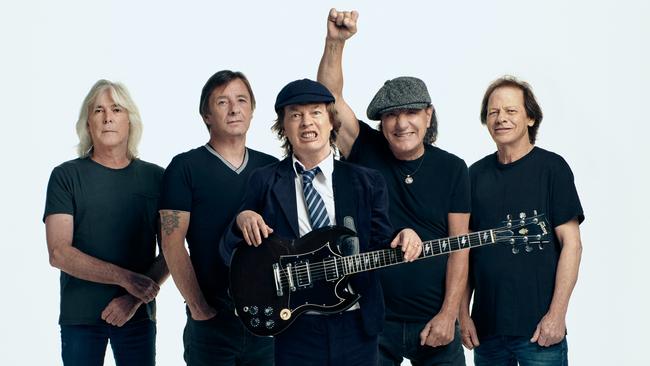
In August 2018, the five musicians — including Johnson, Rudd and Williams — regrouped in Vancouver with producer Brendan O’Brien to record its 17th album; its intended release for earlier this year was delayed by the pandemic. Named Power Up, it’s a strong collection of 12 songs that confirms what just about anyone with ears already knew: the band is nothing if not consistent.
Unlike many of its rock ‘n’ roll competitors, who are forever trying new sounds in an attempt to stay relevant with new audiences while keeping themselves interested, AC/DC’s predictability and dedication to its core values have long been an asset rather than a liability.
“We’ve been very lucky that we strike a chord with a lot of people,” says Angus. “It’s something that amazes me. We’ve been very fortunate through the years that a lot of people hear what you do, and they get excited about what you do.”
AC/DC has built a career making minor variations on major themes, and so it is with album No 17: the riffs are hot, the guitar solos sharp and succinct, the rhythm section has just enough swing and punch to sound unbreakable, and the singer’s distinctive voice is largely unchanged but for occasional moments where his higher, bluesy tones call to mind a younger Robert Plant.
Given all that this mighty group of players has gone through since 1973, together and alone, perhaps the highest compliment that one can pay to Power Up — built on a lifetime of creativity, persistence and inspiration from the Young brothers — is that it f..king rocks.
Power Up is released on November 13 via Columbia/Sony Music.



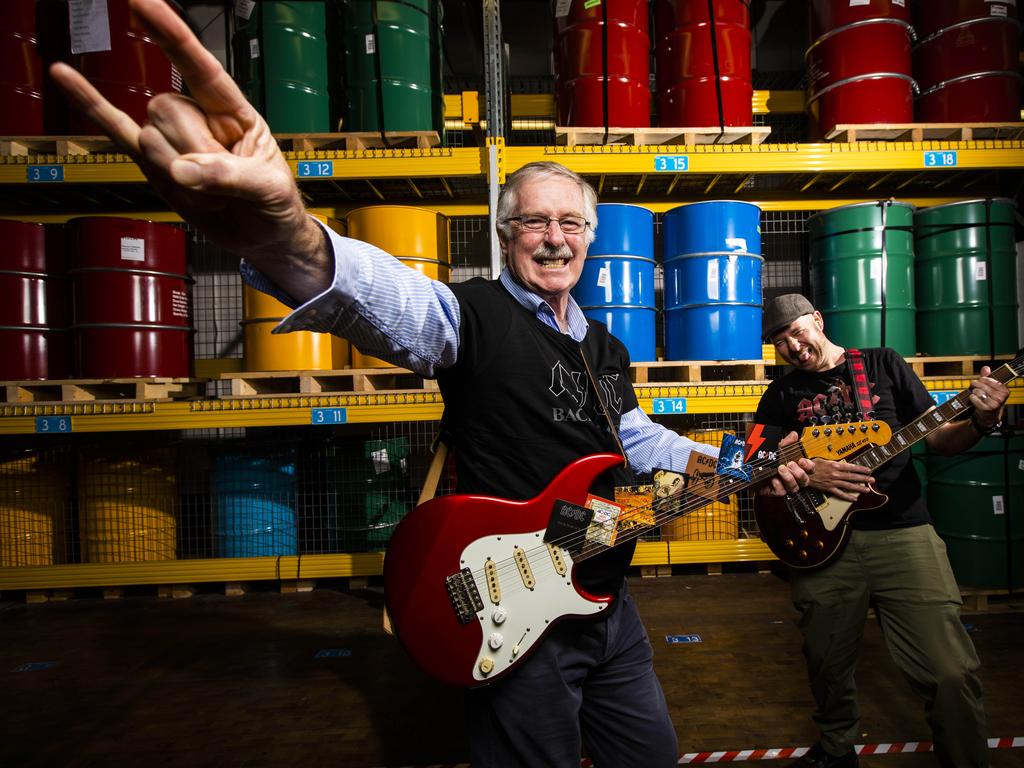


To join the conversation, please log in. Don't have an account? Register
Join the conversation, you are commenting as Logout